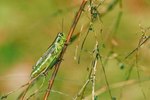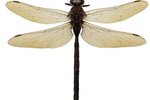
Flies and other insects have a unique ability to walk up walls and wander across ceilings, seemingly without effort. Certain insects have specialized feet that enable them to defy gravity and walk in places that seem to be impossible to cling to. Stiff hairs, natural adhesives and large claws all come into play to enable the insect to walk on smooth, upright or upside-down surfaces.
Pulvilli or Arolia
Flies have two footpads on each foot that are covered with a perpetual adhesive made by the fly's foot itself. These pads are called pulvilli, also known as arolia, and they are covered with a special natural glue made from sugars and oils. This mixture is strong enough to carry the body of the insect as he traverses the obstacles in his path. There is just enough of this glue to correspond with the insect's size.
Setae
The foot pads are covered with tiny hairs that have flattened, hollow tips. These specialized hairs are known as setae and they are the chutes through which the adhesive oils and sugars are transmitted to the pad of the foot. Each time the foot comes into contact with the surface, the adhesive on the footpads connects and clings to that surface. This is why flies tend to leave small, greasy footprints wherever they go.
Two Large Claws
Each foot has a pair of large claws the fly uses to remove his feet from the wall or ceiling, enabling him to walk even though his feet are stuck to the surface. To lift the foot, the fly presses down with the claws and twists the foot a little to remove it from the surface. Each step taken involves this process, which can be accomplished so rapidly, the insect doesn't even appear to pause while walking.
Tiny Hairs on Foot
Insect feet often have microscopic bristle-like hairs, that are stiff enough to find the small inconsistencies in surfaces. Most ceiling and wall materials such as wood, drywall, ceiling tile and even concrete and glass, have very tiny pits and holes, making them porous. Insects can feel the holes and pits in the surface and grab into them with the stiff hairs on the bottoms of their feet. This keeps the insect tethered to the surface.
References
Resources
Photo Credits
-
Digital Vision./Photodisc/Getty Images




